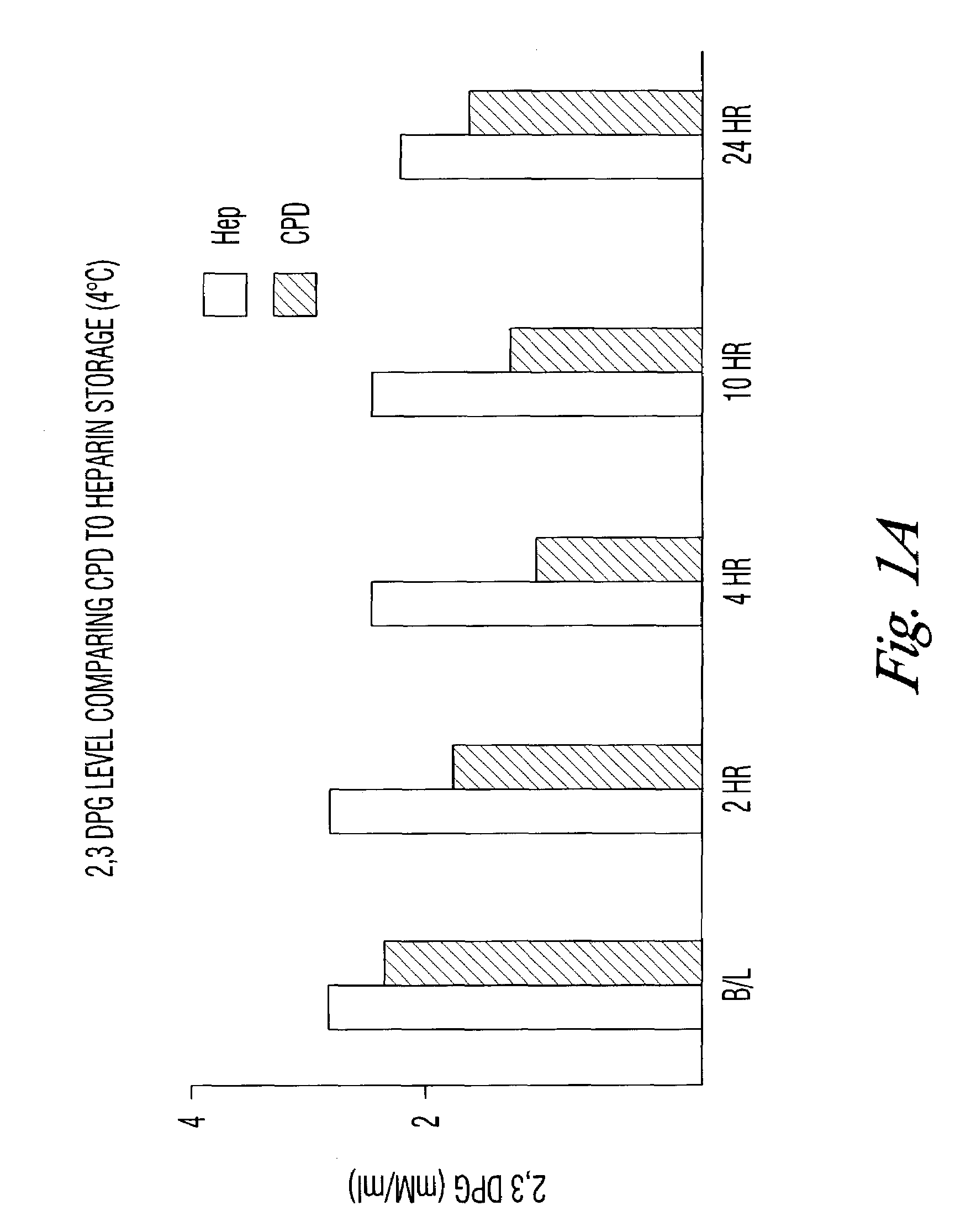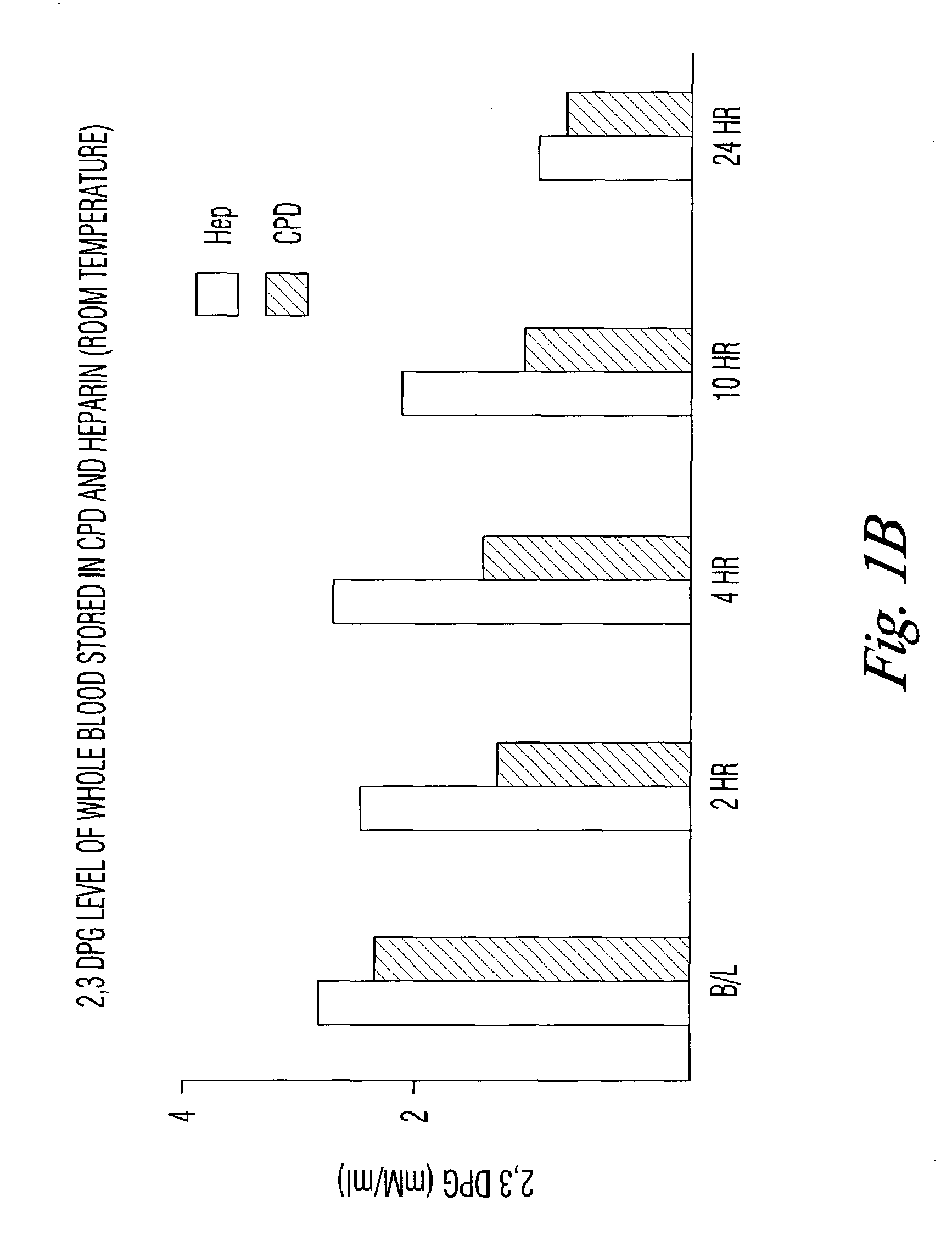Rejuvenation of stored blood
a technology for rejuvenating and storing blood, applied in the field of storage, preservation and rejuvenation of whole blood, can solve problems such as compromising their ability
- Summary
- Abstract
- Description
- Claims
- Application Information
AI Technical Summary
Benefits of technology
Problems solved by technology
Method used
Image
Examples
example 1
Composition for Storage of Whole Blood and Packed RBC.
[0028]At the present time, blood is collected in bags containing CPD or CPDA. The citrate serves as anticoagulant, while the phosphate buffers the lactate that is formed from energy production via glycolysis. Dextrose is added as a substrate for glycolysis. Surprisingly, the inventors have discovered that dextrose can be eliminated when D-ribose is present and the cells remain optimally functional for a longer time. If dextrose is present, the ribose effect is neither diminished nor enhanced.
[0029]Whole blood is collected into a bag containing dry powders or concentrated aqueous solution sufficient to provide a final concentration of 4% sodium citrate, 10 mM sodium phosphate at a pH of 7.4, and 15 mM D-ribose (CPR). When packed RBC are prepared, they are resuspended in plasma containing CPR or a balanced salt solution containing CPR. The bags are stored at refrigerated temperatures, preferably 4° C.
example 2
Determination of Viability of RBC.
[0030]It has been previously shown (Dawson, Blood (1981)) that RBC stored in standard citrate-phosphate-dextrose (CPD) maintains about 26% of its initial 2,3 DPG level at 42 days of storage at 4° C. Adding 15 mM D-ribose and 10 mM phosphate increased the DPG levels at 42 days to about 50%. The inventors have repeated Dawson's studies with the following results:
[0031]
TABLE I2,3 DPG levels, μmol / mlDay, stored atCPDA (CPD plusCPDA plus D-4° C.adenine)Ribose89494156495225777293366378394443351—1656—5
[0032]The results seen in the above verification of Dawson can be accelerated by storing the blood samples at room temperature. To test that assumption, blood collected in the CPD, CPDA, or with phosphate / dextrose plus heparin as an anticoagulant was assayed for DPG content at 4° C. and at room temperature. DPG was measured by following the enzymatic cleavage of 2,3 DPG by activated phosphoglycerate mutase (PGM) in the presence of glycolate-2-phosphate.
[0033]...
example 4
Rejuvenation of Stored RBC.
[0037]A. Example 2 showed that storage at room temperature accelerated the decrease in DPG, the measure of RBC function. Whole blood stored at 4° C. may also have decreased DPG levels. Additionally, many blood banks have a practice of holding blood or RBC at room temperature for eight to 12 hours in order to kill Yersinia sp., a psychrophilic bacterium that is a major contaminant of blood. As shown, it is expected that such blood will have low levels of DPG and hence be suboptimally functional on transfusion.
[0038]An experiment was devised to determine whether the DPG levels could be brought back to approximate initial levels, that is, whether the RBC could be rejuvenated. Whole blood with heparin as anticoagulant was held at room temperature for 6 days, at which time DPG levels were undetectable. D-ribose at 10 mM was added and the blood was incubated at 37° C. for thirty minutes. At the end of the incubation, DPG was assayed again and was found to have i...
PUM
| Property | Measurement | Unit |
|---|---|---|
| temperature | aaaaa | aaaaa |
| pH | aaaaa | aaaaa |
| pH | aaaaa | aaaaa |
Abstract
Description
Claims
Application Information
 Login to View More
Login to View More - R&D
- Intellectual Property
- Life Sciences
- Materials
- Tech Scout
- Unparalleled Data Quality
- Higher Quality Content
- 60% Fewer Hallucinations
Browse by: Latest US Patents, China's latest patents, Technical Efficacy Thesaurus, Application Domain, Technology Topic, Popular Technical Reports.
© 2025 PatSnap. All rights reserved.Legal|Privacy policy|Modern Slavery Act Transparency Statement|Sitemap|About US| Contact US: help@patsnap.com



